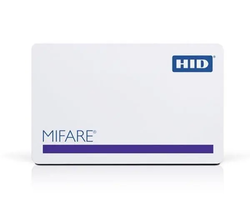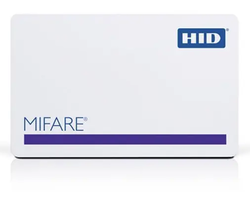MIFARE Cards
HID MIFARE credentials have the memory structure and capacity to store multiple applications on a single credential. Securely separated sectors that are each protected by a set of two keys and programmable access conditions allow complex applications and provide for future expansion. The data on the card is protected with encryption keys used in the mutual authentication process.
HID 801 MIFARE DESFIRE EV3 8K Composite 40% Polyester/PVC – Qty 100
HID 802 MIFARE DESFIRE EV3 8K High Security Composite 40% Polyester/PVC – Qty 100
HID 1436 MIFARE Classic (1K) Composite 40% Polyester/PVC Card – Qty 100
HID 1440 MIFARE Classic (4K) Standard PVC Card – Qty 100
HID 1446 MIFARE Classic (4K) Composite Polyester 40%/PVC Card – Qty 100
HID 3400 MIFARE Classic (1K) Standard PVC Card with SIO encoding – Qty 100
HID 1431 MIFARE Classic + Prox with SIO encoding – Qty 100
HID MIFARE Classic + Prox with SIO encoding – Qty 100
HID 3550 MIFARE Classic + Prox (1K) Composite 40% Polyester/PVC Card with SIO encoding – Qty 100
HID 3506 MIFARE Classic + Prox (4K) Standard PVC Card with SIO encoding – Qty 100
HID 3556 MIFARE Classic + Prox (4K) Composite 40% Polyester/PVC Card with SIO encoding – Qty 100
HID 3406 MIFARE Classic (4K) Standard PVC Card with SIO encoding – Qty 100
HID 3450 MIFARE Classic (1K) Composite 40% Polyester/PVC Card with SIO encoding – Qty 100
HID 3456 MIFARE Classic (4K) Composite Polyester 40%/PVC Card with SIO encoding – Qty 100
WHAT’S THE DIFFERENCE BETWEEN A MIFARE® CARD AND A PROXIMITY CARD?
Proximity cards are read-only contactless devices with an embedded antenna. When the proximity card passes within range, the reader can read the card’s cardholder data. Depending on the reader, the operating “reading” range for proximity cards is between 2.5” and 20” (63.5 mm / 508 mm). Typically used in access-control applications, proximity cards are also used to aid in crowd control.
A proximity card’s embedded microchip has a simple and limited function: to provide the prox-card reader with the card’s ID number or a facility code number, which are then verified by remote computer (usually to grant access). A proximity card does not have the capacity to store values.
MIFARE cards (originally developed for automated fare collection on European public transport systems) feature embedded microchip memory, which can provide identification, authentication and information. MIFARE cards provide the memory structure and capacity to store multiple applications on a single credential. Securely separated sectors are each protected by a set of two keys. Programmable access conditions permit complex applications and provide for future expansion. They are durable and feature encryption keys to keep sensitive information safe and prevent data from being emitted until the MIFARE card and card reader mutually authenticate each other.
MIFARE cards differ from standard proximity cards in three primary ways:
- MIFARE card frequency is 13.56 Mhz. A standard 1386 proximity card is 125KHz.
- The standard MIFARE card is factory programmed with a unique 32-bit serial number. This is a random number and does not contain a facility code. Most 26-bit proximity cards use a facility code within their configurations.
- A MIFARE card has memory for storing values (typically up to 1 kilobyte of data).
A MIFARE card can be programmed with multiple credentials, which adds an extra “handshake” between the card reader and the card reader software. The 13.56 MHz read/write contactless SIO-enabled MIFARE + Prox smart card features memory that can be programmed/used for physical access control, PC logon, biometric verification, time and attendance, as a cash card or a pre-paid membership card (cashless vending), public transportation, airline ticketing, and customer-loyalty programs
WHAT READERS DO I NEED FOR MIFARE CARDS?
RFID Readers and Prox Card Readers — Be sure your cards readers can “read” 13.56 KHz technology cards. Many readers are only able to read the 125KHz frequency. Also, because MIFARE cards are pre-encoded with a unique 32-bit number, be sure your software can read 32-bit formats.
WHY MIFARE?
MIFARE offers something for everyone. It lowers costs, add flexibility, increases control, and produces better consumer interactions—while broadly supporting community safety and security. Among the RFID cards, the MIFARE 13,56 Mhz card is available at the lowest price. A pioneer of passive RFID technology on plastic cards, MIFARE cards are widely used in access control, transport and loyalty systems. Taking advantage of a competitive selling price, largely compatible with multiple identification applications, MIFARE cards THE safe bet for your premises-access management.
MIFARE is the most used chip technology applying RFID cards to ID applications such as access controls, corporate identification cards or loyalty cards. MIFARE chip cards use 13.56 MHz frequency and comply with ISO 14443 Norm. You can purchase MIFARE chip cards either as blank cards or imprinted, encoded and personalized according to your wishes.
WHAT ARE THE PHYSICAL CHARACTERISTICS OF A MIFARE CARD?
- Operating frequency: 13.56 MHz.
- Read range: from about 0cm up to 10 cm.
- Card size: approx. 85.7mm x 54.0mm x 0.8mm.
- Data capacity: a standard 1K Mifare card has 16 sectors each with 4 blocks of data that are16 bytes. Other capacities are available.
HOW SECURE IS THE DATA ON A MIFARE CARD?
- The radio transmission between the MIFARE chip and the reader is encrypted.
- Each sector can be read and can have its own 48-bit keys for read/write access—which allows multiple applications from different vendors to operate on the same card.
- A 48-bit key protects access to data from each sector.
- Data stored on the card can be encrypted or not encrypted.
- Each sector.
WHAT ARE THE ADVANTAGES OF MIFARE CARDS?
- A single card can be used for multiple applications including access control, pin verification, and purse applications.
- Secure encryption prevents unauthorized access to information on the card—which makes it very difficult to copy a MIFARE card.
- “Contactless” means reduced card-reader maintenance and less wear and tear on cards.
- To perform read/write operations, MIFARE cards are not inserted into readers but are merely passed within the card reader’s range.
- Each card has its own unique card serial number.
- Cards can be used in wet environments because card readers can be sealed.







